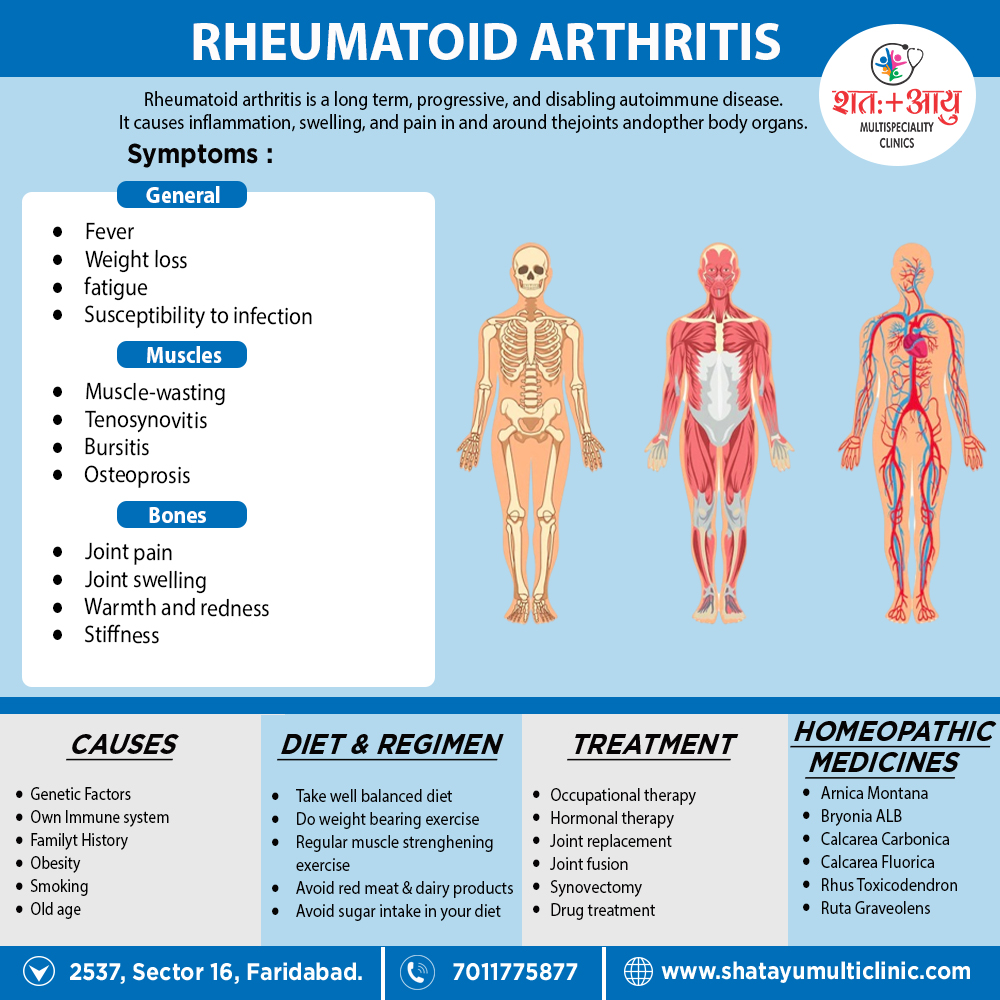Treatment of Rheumatoid Arthritis (RA)
There is no cure for rheumatoid arthritis.
But clinical studies indicate that remission of symptoms is more likely when treatment begins early with medications known as disease-modifying antirheumatic drugs (DMARDs).
Medications:
The types of medications recommended by your doctor will depend on the severity of your symptoms and how long you’ve had rheumatoid arthritis.
NSAIDs i.e.:
- Nonsteroidal anti-inflammatory drugs (NSAIDs) can relieve pain and reduce inflammation.
- Over the counter NSAIDs include ibuprofen (Advil, Motrin IB) and naproxen sodium (Aleve).
- Stronger NSAIDs are available by prescription.
- Side effects may include stomach irritation, heart problems and kidney damage.
Steroids i.e.:
- Corticosteroid medications, such as prednisone, reduce inflammation and pain and slow joint damage.
- Side effects may include thinning of bones, weight gain and diabetes.
- Doctors often prescribe a corticosteroid to relieve acute symptoms, with the goal of gradually tapering off the medication.
Disease-modifying antirheumatic drugs (DMARDs) i.e.:
- These drugs can slow the progression of rheumatoid arthritis also save the joints and other tissues from permanent damage.
- Common DMARDs include methotrexate (Trexall, Otrexup, others), leflunomide (Arava), hydroxychloroquine (Plaquenil) and sulfasalazine (Azulfidine).
- Side effects vary but may include liver damage, bone marrow suppression and severe lung infections.
Biologic agents i.e.:
- Also known as biologic response modifiers, this newer class of DMARDs includes abatacept (Orencia), adalimumab (Humira), anakinra (Kineret), baricitinib (Olumiant), certolizumab (Cimzia), etanercept (Enbrel), golimumab (Simponi), infliximab (Remicade), rituximab (Rituxan), sarilumab (Kevzara), tocilizumab (Actemra) and tofacitinib (Xeljanz).
These drugs can target parts of the immune system that trigger inflammation that causes joint and tissue damage.
These types of drugs also increase the risk of infections.
In people with rheumatoid arthritis, higher doses of tofacitinib can increase the risk of blood clots in the lungs.
Biologic DMARDs are usually most effective when paired with a nonbiologic DMARD, such as methotrexate.
Occupational Therapy:
- Your doctor may send you to a physical or occupational therapist who can teach you exercises to help keep your joints flexible.
- The therapist may also suggest new ways to do daily tasks, which will be easier on your joints.
- For example, you may want to pick up an object using your forearms.
- Assistive devices can make it easier to avoid stressing your painful joints.
- For instance, a kitchen knife equipped with a hand grip helps protect your finger and wrist joints.
- Certain tools, such as buttonhooks, can make it easier to get dressed.
Surgery:
If medications fail to prevent or slow joint damage, you may consider surgery to repair damaged joints.
Surgery may help restore your ability to use your joint.
It can also reduce pain and improve function.
Rheumatoid arthritis surgery may involve one or more of the following procedures:
Synovectomy i.e.:
- Surgery to remove the inflamed lining of the joint (synovium) can be performed on knees, elbows, wrists, fingers and hips.
Tendon repair i.e.:
- Inflammation and joint damage may cause tendons around your joint to loosen or rupture.
- Your surgeon may be able to repair the tendons around your joint.
Joint fusion i.e.:
- Surgically fusing a joint may be recommended to stabilize or realign a joint and for pain relief when a joint replacement isn’t an option.
Total joint replacement i.e.:
- During joint replacement surgery, your surgeon removes the damaged parts of your joint and inserts a prosthesis made of metal and plastic.
- Surgery carries a risk of bleeding, infection and pain. [2]

